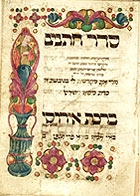Feast Your Eyes

Early next week, an extraordinary private collection will go on display at New York's Yeshiva University Museum, before heading off in the fall to the Israel Museum in Jerusalem. The Braginsky Collection of illuminated manuscripts, ketubot, megillot, and printed volumes is not only visually ravishing but deeply instructive.
The exhibit's many items created in Central Europe in the 15th-19th centuries demonstrate a vibrant visual culture in communities seldom thought of as hotbeds of cultural openness and artistic energy. They are complemented by beautiful objects produced by Sephardic communities from Amsterdam to India, and from Livorno, Italy, a major center of Jewish publishing in the 17th-19th centuries.
Women regularly figure in the collection's pieces, not only as subjects but as participants and creators. A 19th-century Haggadah is the only known Hebrew illuminated manuscript produced by a woman, Charlotte von Rothschild. Even more striking, and also on display separately at the museum, is the earliest known illustrated Megillah, dating to 1564, named for the scribe who wrote and decorated the text, a Venetian woman named Estellina.
Illustrations aside, a random walk—or Internet scroll—through the works in the Braginsky Collection yields a vista of centuries of learning and invention: a 13th-century halakhic compendium written in pellucid Hebrew by a philosophically-minded Italian physician; a 17th-century Torah commentary by the kabbalist Shalom Shabazi, the greatest of the Yemenite Hebrew poets; a beautifully illustrated manucript edition, done in Amsterdam in 1752, of Massekhet Purim, a parody originally written in the 13th century by the Provençal scholar Kalonymos ben Kalonymos.
Exhibits like this new one and last year's display at Sotheby's of the magnificent Valmadonna Trust, together with the scholarly efforts that underlie them, increasingly put to rest the cliché that the Second Commandment made Jewish visual culture impossible. Not only did Jews commission, write, and illustrate these works, they regularly created visual commentaries reflecting their own attitudes toward both the texts and the surrounding culture, enhancing and deepening the age-old Jewish love affair with words.
Comments are closed for this article.




